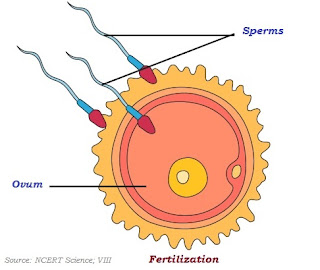What is sexual Reproduction | Defination | Advantages
What is sexual Reproduction | Definition | Advantages?
Reproduction is a life process that enables an organism to reproduce its own offspring. Thus, they continue their species without extinction. Reproduction can take place by the participation of a single parent or two parents. Based on this, we can classify reproduction into two types.
Asexual reproduction: A type of reproduction where a single parent is divided by itself and reproduces its offspring.
Sexual reproduction: A process where two parents participate in producing their offspring. Let’s discuss Sexual Reproduction.
Sexual Reproduction :
Sexual reproduction is defined as the mode of reproduction that involves the infusion of two compatible gametes or sex cells ( male and female gametes). All organisms react to maturity in their life before they can reproduce sexually. In plants, the end of the juvenile or vegetative phase marks the beginning of the reproductive phase and can be seen easily in the higher plants at the time of flowering. Sexual reproduction involves two major events viz. meiosis and fusion of gametes to form a diploid zygote and the production of genetically dissimilar offspring. Sexual reproduction is characterized by a fusion of the male and female gametes (fertilization), the formation of a zygote, and embryogenesis.
All organisms have to reach a certain stage of growth and maturity in their life. before they can reproduce sexually. That period of growth is called the Juvenile phase. It is known as a vegetative phase in plants. This phase is the variable duration in different organisms.
There are concomitant changes in the body (like slowing of metabolism. etc.) during this last phase of life span. Old age ultimately leads to death. In both plants and animals, hormones are responsible for the transitions between the three phases. Interaction between hormones and certain environmental factors regulates the reproductive processes and the associated behavioral expressions of organisms.
Events in sexual reproduction: After attainment of maturity. all sexually reproducing organisms exhibit events and processes that have a remarkable fundamental similarity. even though the structures associated with sexual reproduction are indeed very different. The events of sexual reproduction through elaborate and complex. follow a regular sequence. Sexual reproduction is characterized by the fusion (or fertilization) of the male and female gametes. the formation of zygote and embryogenesis.
Sequential events that occur in sexual reproduction are grouped into three distinct stages are
1. Pre-fertilization,
2. Fertilization and the
3. Post-fertilization.
1. Pre-fertilisation Events: These include all the events of sexual reproduction before the fusion of gametes. The two main pre-fertilization events are gametogenesis and gamete transfer.
a. Gametogenesis: gametogenesis refers to the process of formation of the two types of gametes-male and female. Gametes are haploid cells. In some algae, the two gametes are so similar in appearance that it is not possible to categorize them into male and female gametes.
b. Gamete Transfer: After the Formation of male and female gametes must be physically brought together to facilitate fusion (fertiliSation). Fertilization is the fusion of male and female gametes.
2. Fertilisation :
The most vital event of sexual reproduction is perhaps the fusion of gametes. This process called syngamy results in the formation of a diploid zygote. The term fertilization is also often used for this process. The terms syngamy and fertilization are frequently used though, interchangeably.
In most aquatic organisms, such as a majority of algae and fishes as well as amphibians, syngamy occurs in the external medium (water), i.e., outside the body of the organism. This type of gametic fusion is called external fertilization.
In many terrestrial organisms, belonging to fungi, higher animals such as reptiles birds, mammals, and in a majority of plants (bryophytes, pteridophytes, gymnosperms, and angiosperms), syngamy occurs inside the body of organisms is called internal fertilization.
3. Post-fertilisation Events: Elements in sexual reproduction after the formation of the zygote are called post-fertilization events. Like zygote and embryogenesis.
a. Zygote: Zygote Formation of the diploid zygote is universal in all sexually reproducing organisms. In organisms with external fertilization. a zygote is formed in the external medium (usually water). whereas in that fertilization, the zygote is formed inside the body of the organism.
b. Embryogenesis: Embryogenesis refers to the process of formation and development of an embryo from the zygote. During embryogenesis, the zygote undergoes cell division (mitosis) and cell differentiation. cell division increases the number of cells in the developing embryo while cell differentiation helps groups of cells to undergo certain specialized modifications to forms tissue, organs, organ system, and complete organisms.
Hermaphroditism :
Hermaphroditism occurs in animals where one individual has both male and female reproductive parts. Invertebrates, such as earthworms, slugs, tapeworms, and snails, are often hermaphroditic. Hermaphrodites may self-fertilize or may mate with another of their species, fertilizing each other and both producing offspring. Self-fertilization is common in animals that have limited mobility or are not motile, such as barnacles and clams.
The advantages of sexual reproduction:
1. It produces genetic variation in the offspring.
2. The species can adapt to new environments due to variation, which gives them a survival advantage.
3. A disease is less likely to affect all the individuals in a population.
4. One of the most important advantages of sexual reproduction is that it results in genetic variation among offspring.
5. Genetic recombination is another advantage of sexual reproduction.
